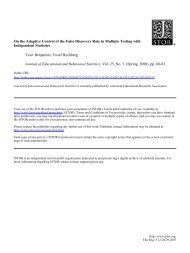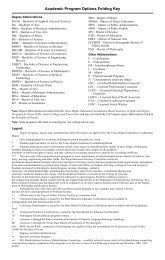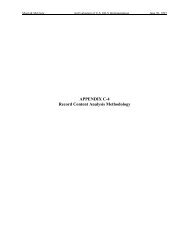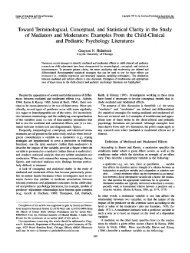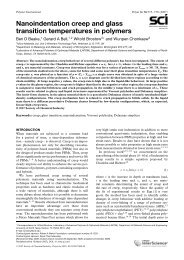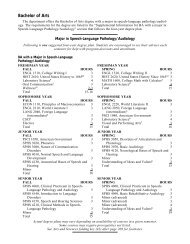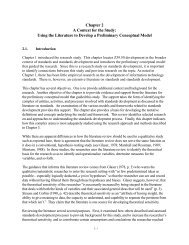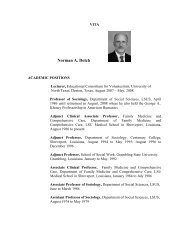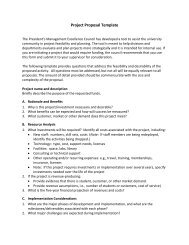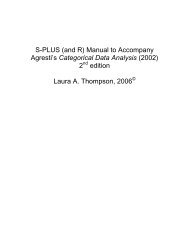An alternative modeling strategy: Partial Least Squares
An alternative modeling strategy: Partial Least Squares
An alternative modeling strategy: Partial Least Squares
Create successful ePaper yourself
Turn your PDF publications into a flip-book with our unique Google optimized e-Paper software.
<strong>An</strong> <strong>alternative</strong> <strong>modeling</strong> <strong>strategy</strong>: <strong>Partial</strong> <strong>Least</strong> <strong>Squares</strong><br />
Dr. Jon Starkweather, Research and Statistical Support consultant.<br />
<strong>Partial</strong> <strong>Least</strong> <strong>Squares</strong> (PLS) <strong>modeling</strong> is often used as an <strong>alternative</strong> to traditional <strong>modeling</strong><br />
techniques. Unlike traditional <strong>modeling</strong> techniques which rely upon covariance decomposition,<br />
PLS is a variance based (or components based) technique and does not carry with it many of the<br />
assumptions of covariance methods (i.e. distributional assumptions). It is sometimes considered<br />
an analysis of last resort because large samples are not as necessary with it, and PLS is less<br />
sensitive to multicollinearity. However, PLS is primarily descriptive when used with small<br />
samples and is still constrained with respect to making inferences about parameters when sample<br />
sizes are small. The benefit of having the ability to do descriptive analysis with small samples is<br />
that PLS can fit models with non-linear relationships and non-Gaussian distributions among the<br />
variables in addition to the traditional linear and Gaussian situations.<br />
PLS is also quite versatile; it can be used as a regression technique, a principal components<br />
technique, a canonical correlation technique, or a path <strong>modeling</strong> (or structural equation<br />
<strong>modeling</strong>) technique. It is well documented that PLS is biased because the optimization is local<br />
rather than global level; however, as sample size increases PLS becomes less bias. PLS can be<br />
used to make inferences about parameters when sample sizes are large. PLS is often used when<br />
other methods fail (i.e. a slightly biased estimate is better than no estimate).<br />
As an example, we will first model a simulated data set using traditional <strong>modeling</strong> techniques<br />
using a popular method and package. John Fox’s (2010) package 'sem' is one of the more<br />
established <strong>modeling</strong> packages in R and will be used here to demonstrate how certain data sets<br />
do not converge on a specified model.<br />
Example<br />
First, import the data from the internet and run the ubiquitous ‘head’ function to get a look at the<br />
data. The example data contains 20 variables (v1 – v20) and 1000 cases. Here we will name the<br />
data ‘pls.data’.
Next, create a covariance matrix object which will be passed on to the ‘sem’ function. The<br />
covariance object is named ‘cov.m’ (some of the matrix in the image below is not shown).
Next, load the ‘sem’ package by typing: library(sem) in the R console. Then, specify the sem<br />
measurement model (i.e. confirmatory factor model). The model specification syntax is given<br />
below (not in an image) due to its length.<br />
measurement.model v1, lam11, NA<br />
F1 -> v2, lam12, NA<br />
F2 -> v3, lam21, NA<br />
F2 -> v4, lam22, NA<br />
F2 -> v5, lam23, NA<br />
F3 -> v6, lam31, NA<br />
F3 -> v7, lam32, NA<br />
F3 -> v8, lam33, NA<br />
F3 -> v9, lam34, NA<br />
F3 -> v10, lam35, NA<br />
F3 -> v11, lam36, NA<br />
F4 -> v12, lam41, NA<br />
F4 -> v13, lam42, NA<br />
F4 -> v14, lam43, NA<br />
F4 -> v15, lam44, NA<br />
F5 -> v16, lam51, NA<br />
F5 -> v17, lam52, NA<br />
F5 -> v18, lam53, NA<br />
F5 -> v19, lam54, NA<br />
F5 -> v20, lam55, NA<br />
v1 v1, var1, NA<br />
v2 v2, var2, NA<br />
v3 v3, var3, NA<br />
v4 v4, var4, NA<br />
v5 v5, var5, NA<br />
v6 v6, var6, NA
v7 v7, var7, NA<br />
v8 v8, var8, NA<br />
v9 v9, var9, NA<br />
v10 v10, var10, NA<br />
v11 v11, var11, NA<br />
v12 v12, var12, NA<br />
v13 v13, var13, NA<br />
v14 v14, var14, NA<br />
v15 v15, var15, NA<br />
v16 v16, var16, NA<br />
v17 v17, var17, NA<br />
v18 v18, var18, NA<br />
v19 v19, var19, NA<br />
v20 v20, var20, NA<br />
F1 F2, cov1, NA<br />
F1 F3, cov2, NA<br />
F1 F4, cov3, NA<br />
F1 F5, cov4, NA<br />
F2 F3, cov5, NA<br />
F2 F4, cov6, NA<br />
F2 F5, cov7, NA<br />
F3 F4, cov8, NA<br />
F3 F5, cov9, NA<br />
F4 F5, cov10, NA<br />
F1 F1, NA, 1<br />
F2 F2, NA, 1<br />
F3 F3, NA, 1<br />
F4 F4, NA, 1<br />
F5 F5, NA, 1<br />
Next, we run the measurement model; but unfortunately, it does not converge.<br />
So, we detach the ‘sem’ package using the following command: detach(“package:sem”) and<br />
decide to use a PLS <strong>strategy</strong>. The ‘plspm’ package (PLS Path Modeling; Sanchez & Trinchera,<br />
2010) provides functions for conducting and graphing a variety of PLS techniques; such as PLS<br />
regression with a single outcome, PLS canonical correlation, PLS regression with multiple<br />
outcomes (similar to canonical correlation, but with directionality implied between the two<br />
composite variates), PLS principal components analysis, and PLS path <strong>modeling</strong> (i.e. SEM).<br />
PLS Path Modeling<br />
Load the package (which three dependencies [amap, diagram, shape]).
First, we must create a matrix which expresses the inner (structural) model; this model simply<br />
shows the relationships among the latent variables; where the column variable 'causes' the row<br />
variable(s) if a 'one' is in the intersecting cell (e.g. f1 and f2 cause f3 --> columns 1 and 2 cause<br />
row 3).<br />
Next, create the list which expresses the outer (measurement) model; this model simply shows<br />
the relationships between the manifest variables and the latent variables (e.g. variables v1 and v2<br />
are related to the first factor [f1]). Although we create a list object in R, this is often referred to<br />
as the outer matrix in the PLS literature.
Next, create a vector which identifies the "mode" of indicators which were used (i.e. "A" for<br />
reflective measurement or "B" for formative measurement). Recall, 'Reflective' measurement is<br />
said to occur when each manifest variable is "caused by" a latent variable and 'Formative'<br />
measurement is said to occur when each manifest variable "causes" the latent variable. Below, all<br />
5 latent variables in our model are "reflectively" measured (i.e. each latent causes the observed<br />
scores on the manifest variables).<br />
Finally, we can run the <strong>Partial</strong> <strong>Least</strong> <strong>Squares</strong> Path Model. One of the benefits of using the<br />
‘plspm’ package rather than one of the other PLS packages available in R, is that the ‘plspm’<br />
package offers some very easy to use and interpret output. Each function provides a description<br />
of the function’s output items and shows how to extract or reference them.<br />
Using the ‘summary’ function on a ‘plspm’ object provides a well-documented and indexed<br />
summary of the analysis’ output. Below you can see that the current summary provides a very<br />
thorough summary with labels for each element which makes interpretation very straighforward.<br />
In fact, the output (from the ‘summary’) is so large that is necessitates four screen capture<br />
images to display it all here.
Continued below.
Continued below.
Continued below.
<strong>An</strong>other big advantage to using the ‘plspm’ package (rather than others available for PLS<br />
<strong>modeling</strong>) is the ability to produce a path diagram based on the model fitted.
<strong>An</strong>other advantage to using the ‘plspm’ package is the ability to conduct bootstrapped cross<br />
validation of a PLS path model using the ‘boot.val’ optional argument to the ‘plspm’ function.<br />
Notice in the above table, there is a “$boot” element in the output. The rest of the output is<br />
identical to what was displayed above. The “$boot” element contains the cross validation output,<br />
which is the only part of the output displayed below.
Continued below.
Interpretation was excluded from this article because the output of the functions covered is<br />
considered fairly intuitive. However, if one would like more information on interpreting PLS<br />
models, see Chin (2010).<br />
Until next time, I’ll drive my Chevy to the leeve..
References & Resources<br />
Chin, W. W. (2010). How to write up and report PLS analyses. In Esposito, V., et al. (eds.),<br />
Handbook of <strong>Partial</strong> <strong>Least</strong> <strong>Squares</strong> (pp. 655 – 688). New York: Springer-Verlag.<br />
Diamantopoulos, A., & Siguaw, J. A. (2006). Formative versus reflective indicators in<br />
organizational measure development: A comparison and empirical illustration. British<br />
Journal of Management, 17, 263 – 282.<br />
Falk, R. F., & Miller, N. B. (1992). A primer for soft <strong>modeling</strong>. Akron, OH: University of Akron<br />
Press.<br />
Garson, D. (2011). <strong>Partial</strong> <strong>Least</strong> <strong>Squares</strong>. Statnotes. Accessed May 9, 2011; from:<br />
http://faculty.chass.ncsu.edu/garson/PA765/pls.htm<br />
Haenlein, M., & Kaplan, A. (2004). A beginner's guide to partial least squares analysis.<br />
Understanding Statistics, 3(4), 283 -- 297. Available at:<br />
http://www.stat.umn.edu/~sandy/courses/8801/articles/pls.pdf<br />
Lohmoller, J. (1989). Latent variable path <strong>modeling</strong> with partial least squares. New York:<br />
Springer-Verlag.<br />
Marcoulides, G. A., & Saunders, C. (2006). PLS: A silver bullet? MIS Quarterly, 30, iii – ix.<br />
Sanchez, G. (2010). Package 'plspm'. Available at CRAN: http://cran.rproject.org/web/packages/plspm/index.html<br />
Tenenhaus, M., Vinzi, V. E., Chatelin, Y., & Lauro, C. (2005). PLS path <strong>modeling</strong>.<br />
Computational Statistics & Data <strong>An</strong>alysis, 48, 159 -- 205. Available at:<br />
www.sciencedirect.com<br />
Trinchera, L. (2007). Unobserved heterogeneity in structural equation models: A new approach<br />
to latent class detection in PLS path <strong>modeling</strong>. Doctoral dissertation. Available at:<br />
http://www.fedoa.unina.it/view/people/Trinchera,_Laura.html



